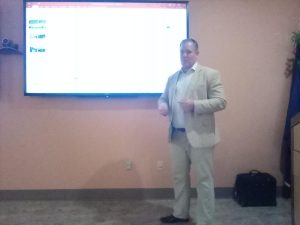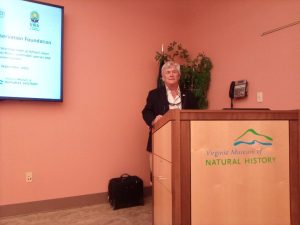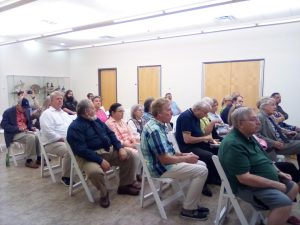
Michael Keigwin, the founder of the Uganda Conservation Foundation, stopped in Martinsville recently as part of his lecture series in the U.S.
Bill Martin, president and founder Blue Ridge Aquaculture, a large indoor fishery in Martinsville, said he has worked with Keigwin for years and welcomed the opportunity to help host him at the Virginia Museum of Natural History.
Noting their lengthy partnership and friendship, Martin said many years ago, Keigwin discussed the idea of Martin’s company installing a fishery in Uganda. While that did not materialize, Martin said their work together has continued.
“Things just kind of developed from there, and our friendship that we’ve had for a long time now,” Martin said, and outlined some of Keigwin’s efforts in Uganda since 1997.
“Michael is the founder of this Uganda Conservation Foundation. He did a lot of work in the parks all over Africa, but in Uganda primarily, and trained and equipped rangers, does anti-poaching protecting elephants, lions, and giraffes,” Martin said.

In presenting more in-depth information about the foundation, Keigwin said he initially did not plan to get involved in conservation, and he believes that the current attitude towards getting involved in or funding the field has faults.
“It wasn’t a plan. There was no plan. There is no career path into this type of conservation. It’s one of the things I find really bad. It’s become an elitist thing where the only conservation money runs through academia and they exclude others, and frankly that’s not what we need in the parks,” he said.
Keigwin, who is from England, promotes and directs conservation efforts in Uganda, primarily in Murchison Falls, Kidepo, and Queen Elizabeth national parks.
But he said the idea of a national park originated in America.
“The National Park concept actually came from America. In the 1950s people said, ‘Actually, do you know what? There’s an idea here. We could protect some of the most wonderful places around the world, and why don’t we,’” Keigwin said.
His goal with the lecture series, which will include places in the United States such as San Francisco and other areas, goes beyond trying to raise funds with partners who have helped his foundation along the way. He also aims to show others that they can get involved in conservation, regardless of their skills or background.

“There’s a big movement at the moment, which has been going on for about 10 years, where professional skills are being encouraged,” Keigwin said. “One of the things that we’re all trying to do now is say to people, ‘If you want to get involved in conservation, park management, and whatever else, there is a route. You don’t have to be a PhD vet; you don’t have to be an incredible botanist or whatever. You can be whatever skill you’ve got.’”
He also hopes to provide a more direct line of communication and information for those who are interested in conservation.
“Previously, they had seen a program on TV. Now they’re actually getting front line. ‘Would you like to meet the head ranger? Here he is. Would you like to ask him or her a question?’ It’s bringing people together, to this directly,” Keigwin said.
He is hopeful the lecture series will encourage those who are curious about conservation to apply their skills and interests, whatever they may be.
“There are just endless opportunities. It doesn’t have to be about publishing papers. The skills that the world has are everywhere,” he said.
An estimated 30 people attended the event at the museum, including Dr. Joe Keiper, executive director of the VMNH.
“This is a pretty special experience,” Keiper said. “It’s great when we have travelers who come around and then volunteer their services.”




